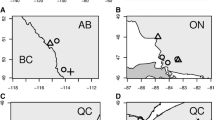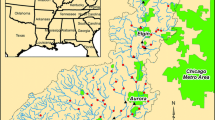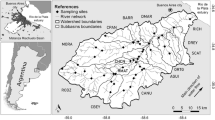Synopsis
Principal components analysis was performed on fish presence/absence data for 39 common fish species from 410 stream sites in Kansas. The analysis confirmed ten ecologically meaningful fish assemblages, based on species associations. Factor scores based on these assemblages were then clustered into six geographic areas or fish ecoregions. Canonical discriminant analysis identified environmental variables that distinguished the derived fish ecoregions. Mean annual runoff, mean annual growing season, and discharge appear most important. Mean width, mean depth, chloride concentration, water temperature, substrate type, gradient, and percent of pool habitat were less important. Correspondence exists between these fish ecoregions and the patterns of physiographic regions, river basins, geology, soil, and potential natural vegetation in Kansas. The multivariate statistical approach used to classify fish ecoregions should have considerable potential value for fish assessment and management purposes in areas other than the state of Kansas.
Similar content being viewed by others
References cited
Balon, E.K. & D.J. Stewart. 1983. Fish assemblages in a river with unusual gradient (Luongo, Africa - Zaire System), reflections on river zonation, and description of another new species. Env. Biol. Fish. 9: 225–252.
Buzas, M.A. 1972. Patterns of species diversity and their explanation. Taxon 21: 275–286.
Cooley, W.W. & P.R. Lohnes. 1971. Multivariate data analysis. John Wiley and Sons, New York. 364 pp.
Cross, F.B. 1967. Handbook of fishes of Kansas. Museum of Natural History, University of Kansas, Lawrence. 357 pp.
Cross, F.B. & J.T. Collins. 1975. Fishes in Kansas. University of Kansas, Museum of Natural History, Public Education Series No. 3, Lawrence. 189 pp.
Deacon, J.E. & A.L. Metcalf. 1961. Fishes of the Wakarusa River in Kansas. University of Kansas Publication, Museum of Natural History 13: 309–322.
Echelle, A.A. & G.D. Schnell. 1976. Factor analysis of species associations among fishes of the Kiamichi River, Oklahoma. Trans. Amer. Fish. Sec. 105: 17–31.
Fausch, K.D., J.R. Karr & P.R. Yant. 1984. Regional application of an index of biotic integrity based on stream fish communities. Trans. Amer. Fish. Soc. 113: 39–55.
Gauch, H.G., Jr. 1982. Multivariate analysis in community ecology. Cambridge University Press, Cambridge. 298 pp.
Gower, J.C. 1966. Some distance properties of latent root and vector methods used in multivariate analysis. Biometrika 53: 325–338.
Green, H.R. 1979. Sampling design and statistical methods for environmental biologists. John Wiley and Sons, New York. 257 pp.
Gulland, J.A. 1977. Goals and objectives of fishery management. FAO Fisheries Technical Paper FIRS/T166, Rome. 14 pp.
Huet, M. 1954. Biologie, profils en long et en travers des eaux courantes. Bull. franc. Piscic. 175: 41–53.
Hughes, R.M. & J.M. Omernik. 1981. A proposed approach to determine regional patterns in aquatic ecosystems. pp. 92–102. In: N.B. Armentrout (ed.) Acquisition and Utilization of Aquatic Habitat Inventory Information, Proceedings of a Symposium, American Fisheries Scociety, Bethesda.
Karr, J.R. 1981. Assessment of biotic integrity using fish communities. Fisheries 6: 21–27.
Kerr, S.R. 1982. The role of external analysis in fisheries science. Trans. Amer. Fish. Soc. 111: 165–170.
Larkin, P.A. 1977. An epitaph for the concept of maximum sustained yield. Trans. Amer. Fish. Soc. 106: 1–11.
Larkin, P.A. 1978. Fisheries management — an essay for ecologists. Annual Review of Ecology and Systematics 9: 57–73.
Layher, W.G. 1983. Habitat suitability for selected adult fishes in prairie streams. Ph. D. Thesis, Oklahoma State University, Stillwater. 333 pp.
Layher, W.G. & O.E. Maughan. 1984. Analysis and refinement of habitat evaluation procedures for eight warm-water fish species. pp. 182–250. In: J.W. Terrell (ed.) Proceedings of a Workshop on Fish Habitat Suitability Index Models, U.S. Fish. Wildl. Serv. Biol. Rep. 85(6).
Layher, W.G. & O.E. Maughan. 1985. Relations between habitat variables and channel catfish populations in prairie streams. Trans. Amer. Fish. Soc. 114: 771–781.
Legendre, L. & P. Legendre. 1983. Numerical ecology. Developments in Environmental modelling, No. 3. Elsevier Scientific Publishing Company, Amsterdam. 419 pp.
Legendre, P. & V. Legendre. 1984. Postglacial dispersal of freshwater fishes in the Quebec peninsula. Can. J. Fish. Aquat. Sci. 41: 1781–1802.
McHugh, J.L. 1970. Trends in fishery research. American Fisheries Society Special Publication 7: 25–56.
Metcalf, A.L. 1966. Fishes of the Kansas River system in relation to zoogeography of the Great Plains. University of Kansas Publication, Museum of Natural History 17: 23–189.
Milligan, G.W. & M.C. Cooper. 1985. An examination of procedures for determining the number of clusters in a data set. Psychometrika 50: 159–179.
Omi, P.N., L.C. Wensel & J.L. Murphy. 1979. An application of multivariate statistics to land-use planning: classifying land units into homogeneous zones. Forest Science 25: 399–414.
Peterson, C.H. 1976. Relative abundance of living and dead molluscs in two California lagoons. Lethaia 9: 137–148.
Pflieger, W.L., M.A. Schene, Jr. & P.L. Haverland. 1981. Techniques for the classification of stream habitats, with examples of their application in defining the stream habitats of Missouri. pp. 362–368. In: N.B. Armentrout (ed.) Acquisition and Utilization of Aquatic Habitat Inventory Information, Proceedings of a Symposium, American Fisheries Society, Bethesda.
Poole, R.W. 1971. The use of factor analysis in modelling natural communities of plants and animals. Illinois Natural History Survey, Biological Notes No. 72, Urbana. 14 pp.
Regier, H.A. 1978. A balanced science of renewable resources. University of Washington Press, Seattle. 108 pp.
Regier, H.A. & H.G. Henderson. 1973. Toward a broad ecological model of fish communities and fisheries. Trans. Amer. Fish. Soc. 102: 56–72.
Rose, D.R. & A.A. Echelle. 1981. Factor analysis of associations of fishes in Little River, central Texas, with an interdrainage comparison. Amer. Mid. Natur. 106: 379–391.
Robins, C.R., R.M. Bailey, C.E. Bond, J.R. Brooker, E.A. Lachner, R.N. Lea & W.B. Scott. 980. List of common and scientific names of fishes from the United States and Canada. American Fisheries Society Special Publication No. 12, Bethesda. 174 pp.
SAS Institute Inc. 1982. SAS User"s Guide: Statistics, 1982 Edition. SAS Institute Inc., Cary. 584 pp.
Self, H. 1978. Environment and man in Kansas. A geographical analysis. The Regents Press of Kansas, Lawrence. 288 pp.
Smart, P.F.M., S.E. Meacock & J.M. Lambert. 1974. Investigations into the properties of quantitative vegetational data. I. Pilot study. J. Ecol. 62: 735–760.
Smith, G.R. & D.R. Fisher. 1970. Factor analysis of distribution patterns of Kansas fishes. pp. 259–277. In: W. Dort, Jr. & J.K. Jones, Jr. (ed.) Pleistocene and Recent Environments of the Central Great Plains, University of Kansas, Department of Geology, Special Publication 3, University of Kansas Press, Lawrence.
Stevenson, M.M., G.D. Schnell & R. Black. 1974. Factor analysis of fish distribution patterns in western and central Oklahoma. Systematic Zoology 23: 202–218.
Thorpe, R.S. 1976. Biometric analysis of geographic variation and racial affinities. Biol. Rev. 51: 407–452.
Tonn, W.M. & J.J. Magnuson. 1982. Patterns in the species composition and richness of fish assemblages in northern Wisconsin lakes. Ecology 63: 1149–1166.
Tonn, W.M., J.J. Magnuson & A.M. Forbes. 1983. Community analysis in fishery management: an application with northern Wisconsin lakes. Trans. Amer. Fish. Soc. 112: 368–377.
U.S. Geological Survey. 1970. The national atlas of the United States. U.S. Government Printing Office. Washington, D.C. 427 pp.
U.S. Geological Survey. 1976. Hydrologic unit map. 1974. State of Kansas. Prepared in cooperation with the U.S. Water Resources Council. USDI Geological Survey, Reston.
Author information
Authors and Affiliations
Rights and permissions
About this article
Cite this article
Hawkes, C.L., Miller, D.L. & Layher, W.G. Fish ecoregions of Kansas: stream fish assemblage patterns and associated environmental correlates. Environ Biol Fish 17, 267–279 (1986). https://doi.org/10.1007/BF00001493
Received:
Revised:
Issue Date:
DOI: https://doi.org/10.1007/BF00001493




